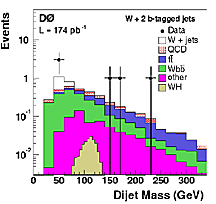DZero continues search for a possible light Higgs

According to DOE Pulse, scientists of the DZero experiment at the Department of Energy's Fermilab have submitted results of the first Run II search for a light Higgs, hypothesized at 115 GeV/c**2. In this search, DZero looks for events where the W boson decays to leptons and the Higgs boson decays to a b-quark, anti b-quark pair.
Image: Distribution of the dijet invariant mass for W + 2b-tagged events: the 6 observed events (black circles) are compared to the simulated standard model contributions (cumulative histograms). The expectation for a 115 GeV Higgs boson from WH production is also shown (brown histogram). (Credit: DOE Pulse)
The real data unfortunately shows no evidence that this is the scenario. But this non-observation allows DZero to set new limits on the critical W-Higgs production rate, which can set limits on theoretical ideas outside the standard model. And it holds out some hope that the Tevatron might produce evidence of a light Higgs.
The DØ Experiment consists of a worldwide collaboration of scientists conducting research on the fundamental nature of matter. The experiment is located at the world's premier high-energy accelerator, the Tevatron Collider, at the Fermi National Accelerator Laboratory (Fermilab) in Batavia, Illinois, USA. The research is focused on precise studies of interactions of protons and antiprotons at the highest available energies. It involves an intense search for subatomic clues that reveal the character of the building blocks of the universe.
Source: DOE Pulse















